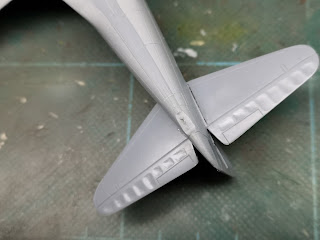Another Shiden-kai model to admire, this time built from the 1/72 Aoshima kit by Francesco Borraccino and representing A-343-37, a less modelled aircraft of 301 Hikotai of the famous 343 Ku.
From his build Francesco assessed this kit as double-faced; with well moulded detail generally and especially for the cockpit and engine, but a challenging fit of parts to say the least.
Francesco noted a poor fit of the wing and tailplane to fuselage joints with large gaps to fill, mostly on the underside, and a different level between the wings and fairings. Also an inexplicable upper fuselage joint where two bulges are formed resulting in a nightmare to fill and sand (see pics). The pin for mounting the engine is too large and crooked requiring remedial work.
In addition the undercarriage gear legs and doors are marred by ejector pin marks with the doors lacking the opening and closing mechanism which Francesco fabricated from plastic card and copper wire. He found the instructions for assembling the undercarriage parts were poor which contributed to an error in direction which required extra work to rectify. The undercarriage proved a loose fit so Francesco resorted to cyanoacrylic cement to achieve a strong bond.
The cockpit interior was finished with a mixture of AK Real Colors RC306 Mitsubishi Interior Green and RC330 Ohryoku Nana Go Shoku.
After final assembly Francesco finished the model with a variety of paints. For the natural metal under surface he applied AK Xtreme Metals with Matt Aluminium as a base coat, and panels of different shades such as Dark Aluminium, Polished Aluminium, etc. Without a clear reference to the under surface Francesco represented the panels arbitrarily. The upper surfaces and spinner were painted with AK Real Colors RC304 D1 Deep Green Black, whilst the prop was finished with a mix of Gunze H-462 Black Brown, H-463 Red Brown and H-84 Mahogany.

Francesco painted the upper and lower wing hinomaru but had problems with masking so for the fuselage applied Techmod decals. He chose '37' rather than the usual '15' or '03' but had to hand paint the numeral on the fuselage and the tail code using Winsor & Newton yellow gouache, not perfect but he hopes acceptable. Undercarriage gear legs were painted dull aluminium with the inside faces of the main doors satin black. The drop tank was painted with Real Colors RC302 J3 Hai iro.
Finally weathering was accomplished with an oil wash and some fading using oils, pastels and pigments, bearing in mind that photographs suggest the aircraft were not so worn and had a relatively short operational life.

Shiden-kai 343-37 was flown by WO Shoji Shibata, leading the 1st Kutai of the 1st Chutai's 2nd Shotai during the 12 April 1945 intercept mission; by WO Isamu Miyazaki leading the 2nd Kutai of the 3rd Chutai's 2nd Shotai on the 16 April sortie; by PO2/c Ken Okimoto of the 3rd Kutai of the 3rd Chutai's 1st Shotai on the 21 April sortie; and finally by Lt Masaji Matsumura leading the 2nd Kutai of the 1st Chutai's 2nd Shotai for an aborted sortie against B-29s on 22 April. In the 343rd the term Kutai referred to a Division of four aircraft deployed in pairs for which the English term 'pair' was used. A Shotai consisted of one to three Kutai from four to 12 aircraft. A Chutai was a tactical formation of usually two Shotai. The purpose of the numbers painted within the hinomaru, whether for training or maintenance, are disputed even by former members of the unit, and it is uncertain whether they were removed by all squadrons before combat operations began. Former 301 maintenance PO Wakashige Kondo stated that they were applied "with a solution of lime and water with a little amount of adhesive agent so that they could be easily erased" and that they were ordered to be removed after combat on 19 March 1945.*

With very special thanks to Francesco for kindly sharing these images and details of his excellent build, and for his patience in waiting for them to appear here.
*'Genda's Blade - Japan's Squadron of Aces 343 Kokutai' by Henry Sakaida and Koji Takaki (Classic Publications, 2003)
Image credit: All photographs © 2021 Francesco Borraccino








































